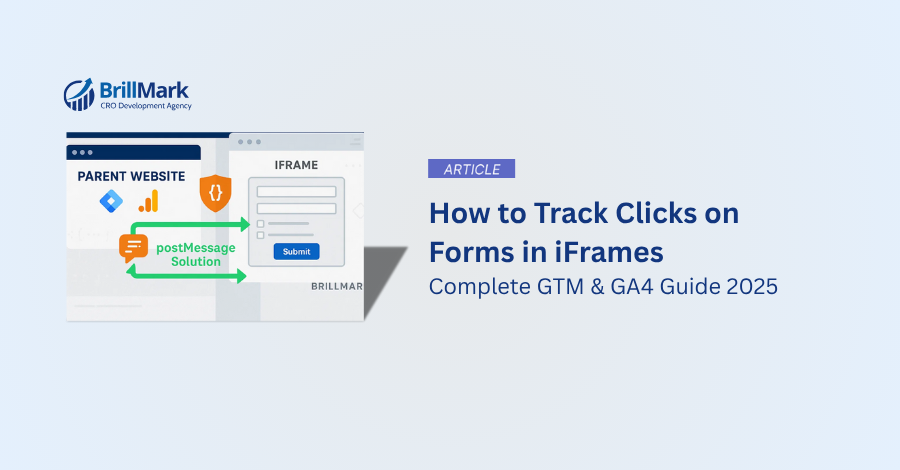Your iframe forms are invisible to Google Analytics. Every lead, every conversion, every click happening inside embedded forms – completely untracked. You’re losing attribution data, your conversion reports are wrong, and you can’t optimize what you can’t measure. Here’s how to fix iframe tracking once and for all.
Real example: Your Calendly booking form, TypeForm survey, or payment gateway sits in an iframe. Users submit forms all day, but your GA4 shows zero conversions. Your A/B testing data is incomplete if experimentation setup and development aren’t good. Your marketing attribution is broken. Time to fix this.
What is iframe Form Tracking and Why It’s Broken
iframe form tracking means capturing user interactions (clicks, submissions, completions) that happen inside embedded iframe content. Standard tracking fails because browsers enforce strict security policies that isolate iframe content from parent pages.
Understanding iframe Security Limitations
The Same-Origin Policy (SOP) is the root problem. This browser security feature prevents scripts from one domain accessing content from another domain. So your main website can’t see what happens inside a cross-domain iframe.
Technical reality: Your GTM container on yoursite.com cannot track events inside an iframe from forms.typeform.com. The iframe operates in complete isolation due to browser security policies enforced by the Same-Origin Policy.
Impact on analytics:
- Form submissions go untracked
- Click events inside iframes are invisible
- User journey data gets fragmented
- Conversion attribution breaks completely
Same-Origin Policy Impact on Analytics
SOP creates these specific tracking failures:
GTM limitations:
- Auto-event listeners don’t work across domains
- Form submission triggers fail
- Click tracking stops at iframe boundaries
- Element visibility triggers can’t see iframe content
GA4 data problems:
- Missing conversion events
- Broken user journey mapping
- Separate Client IDs for same user
- Inaccurate attribution reporting
How to Identify iFrames on Your Website
Quick visual check: Right-click inside suspected content. If you see “View Frame Source” or “Reload Frame” options, it’s an iframe.
Developer tools method:
- Right-click → Inspect Element
- Look for
<iframe>tags in HTML - Check the
srcattribute for domain differences
Console detection:
// Count iframes on page
console.log(document.querySelectorAll('iframe').length);
// List all iframe sources
document.querySelectorAll('iframe').forEach((iframe, index) => {
console.log(`iframe ${index}: ${iframe.src}`);
});Domain verification: Click “View Frame Source.” If it opens a tab with a different domain than your main site, you’ve got cross-domain iframe issues.
The postMessage Solution for Cross-Domain Form Tracking
postMessage is the only reliable method for tracking cross-domain iframe interactions. It’s a built-in JavaScript API that allows secure communication between different origins while respecting browser security policies.
Why postMessage Works for iframe Analytics
Security-compliant: Works within Same-Origin Policy constraints by providing controlled cross-domain communication.
GA4 compatible: Events get pushed to your parent page’s dataLayer, maintaining consistent Client IDs and session data.
Flexible: Can track any interaction – form submissions, button clicks, page views, custom events.
Reliable: Supported by all modern browsers with consistent behavior.
Setting Up Parent Page Message Listeners
Add this listener code to your parent page <head> section:
<script>
// Data layer helper function
function buildData(data) {
window.dataLayer = window.dataLayer || [];
dataLayer.push(data);
}
// Message listener for iframe events
window.addEventListener(
"message",
(event) => {
// CRITICAL: Replace with your iframe's exact domain
if (event.origin !== "https://your-iframe-domain.com") {
console.warn("Unauthorized message from:", event.origin);
return;
}
// Push iframe data to parent's dataLayer
buildData(event.data);
console.log("iframe event received:", event.data);
},
false
);
</script>
Security note: The event.origin check is mandatory. Never skip this validation – it prevents malicious sites from injecting fake data into your analytics.
Configuring iframe Message Senders
Add this code to your iframe’s HTML:
<script>
// Function to send data to parent
function pushToParent(message) {
// CRITICAL: Replace with your parent domain
parent.postMessage(message, "https://your-parent-domain.com");
console.log("Message sent to parent:", message);
}
// Event handlers for tracking
function setupIframeTracking() {
// Track all form submissions
document.querySelectorAll("form").forEach(form => {
form.addEventListener("submit", function(e) {
const formData = {
event: "iframe_form_submit",
form_id: this.id || this.name || "unknown_form",
form_action: this.action || "unknown_action",
form_method: this.method || "unknown_method",
iframe_url: window.location.href,
timestamp: Date.now()
};
pushToParent(formData);
});
});
// Track specific button clicks
document.querySelectorAll("button[data-track]").forEach(button => {
button.addEventListener("click", function(e) {
const clickData = {
event: "iframe_button_click",
button_text: this.innerText,
button_id: this.id,
iframe_url: window.location.href,
timestamp: Date.now()
};
pushToParent(clickData);
});
});
// Track page views within iframe
const pageviewData = {
event: "iframe_pageview",
page_title: document.title,
page_url: window.location.href,
timestamp: Date.now()
};
pushToParent(pageviewData);
}
// Initialize tracking when DOM is ready
if (document.readyState === "loading") {
document.addEventListener("DOMContentLoaded", setupIframeTracking);
} else {
setupIframeTracking();
}
</script>
Step-by-Step GTM Configuration for iframe Tracking
Once postMessage sends data to your parent’s dataLayer, configure GTM to process these events.
Creating Custom Event Triggers
Step 1: Create iframe form submission trigger
- Trigger Type: Custom Event
- Event name:
iframe_form_submit - Fire on: All Custom Events
Step 2: Create iframe click trigger
- Trigger Type: Custom Event
- Event name:
iframe_button_click - Fire on: All Custom Events
Step 3: Create iframe pageview trigger
- Trigger Type: Custom Event
- Event name:
iframe_pageview - Fire on: All Custom Events
Building Data Layer Variables
Create these variables to capture iframe data:
Form tracking variables:
- Variable Name:
iframe_form_id - Variable Type: Data Layer Variable
- Data Layer Variable Name:
form_id - Variable Name:
iframe_form_action - Variable Type: Data Layer Variable
- Data Layer Variable Name:
form_action
Click tracking variables:
- Variable Name:
iframe_button_text - Variable Type: Data Layer Variable
- Data Layer Variable Name:
button_text - Variable Name:
iframe_url - Variable Type: Data Layer Variable
- Data Layer Variable Name:
iframe_url
Setting Up GA4 Event Tags
Form submission tag:
- Tag Type: Google Analytics: GA4 Event
- Configuration Tag: [Your GA4 Config Tag]
- Event Name:
generate_lead - Event Parameters:
form_id:{{iframe_form_id}}form_action:{{iframe_form_action}}source:iframe
- Triggering:
iframe_form_submit
Button click tag:
- Tag Type: Google Analytics: GA4 Event
- Configuration Tag: [Your GA4 Config Tag]
- Event Name:
iframe_interaction - Event Parameters:
button_text:{{iframe_button_text}}page_location:{{iframe_url}}
- Triggering:
iframe_button_click
Advanced iframe Tracking Methods
Installing GTM Directly in iFrames
When to use: You have complete control over iframe source code and want granular tracking before sending to parent.
Setup process:
- Create separate GTM container for iframe
- Install GTM snippets on every iframe page
- Configure internal tracking (optional)
- Use postMessage to send data to parent
Code for iframe GTM integration:
// In iframe's GTM custom HTML tag
<script>
// Listen for GTM events and forward to parent
window.addEventListener('gtm.js', function(event) {
// Forward specific events to parent
if (event.detail && event.detail.event) {
parent.postMessage({
event: 'iframe_gtm_event',
gtm_data: event.detail
}, 'https://your-parent-domain.com');
}
});
</script>Critical limitation: Cross-domain iframes generate separate Client IDs. Always use postMessage to centralize data on parent domain for unified user journey tracking.
Platform-Specific API Solutions
Major platforms provide JavaScript APIs for embedded content tracking:
TypeForm Embed API:
<script src="https://embed.typeform.com/embed.js"></script>
<script>
window.tf.load('your-form-id', {
onSubmit: function() {
dataLayer.push({
event: 'typeform_submit',
form_type: 'typeform',
form_id: 'your-form-id'
});
}
});
</script>
Calendly Embed API:
<script src="https://assets.calendly.com/assets/external/widget.js"></script>
<script>
window.addEventListener('calendly.event_scheduled', function(e) {
dataLayer.push({
event: 'calendly_booking',
event_details: e.data.event
});
});
</script>
Limitations:
- Restricted to API-exposed events
- Platform-dependent functionality
- Limited customization options
- May not capture all desired interactions
Third-Party Tracking Tools
Tools like Hotjar, FullStory, or Crazy Egg claim iframe tracking capabilities:
Reality check:
- Usually track general iframe interactions, not specific form fields
- Limited to click heatmaps and session recordings
- Don’t provide granular event data for GTM/GA4
- Require separate subscriptions and integrations
Better alternative: Implement postMessage for complete control and detailed event data.
Cross-Domain Data Sharing Challenges
Beyond tracking, cross-domain iframes create data sharing problems for personalization and testing.
localStorage Issues Across Domains
The problem: localStorage is domain-specific. The data set main-site.com isn’t accessible on billing.main-site.com.
Real scenario:
- User starts form on
https://demo-app.com/register - Gets redirected to
https://billing.demo-app.com/pricing - Personalization data from testing tools is lost
- User experience breaks
Solutions:
Option 1: URL parameter passing
// On main domain
const userData = {
segment: 'premium',
source: 'google_ads'
};
const params = new URLSearchParams(userData);
window.location.href = `https://billing.demo-app.com/pricing?${params}`;
Option 2: postMessage for data sharing
// iframe receives and stores data
window.addEventListener('message', function(event) {
if (event.origin !== 'https://main-domain.com') return;
// Store received data locally
localStorage.setItem('shared_data', JSON.stringify(event.data));
});
Handling Authentication Redirects
Redirect problem: Many billing/checkout pages redirect unauthenticated users back to main domain, breaking postMessage communication.
Solution strategies:
Stable endpoint approach: Work with development team to create non-redirecting URLs for data sharing:
// Instead of billing.domain.com/checkout (redirects)
// Use billing.domain.com/data-bridge (stable)
Conditional loading: Check authentication state before iframe communication:
function checkAuthAndCommunicate() {
fetch('/auth-status')
.then(response => response.json())
.then(data => {
if (data.authenticated) {
// Safe to use postMessage
setupIframeTracking();
} else {
// Handle unauthenticated state
redirectToLogin();
}
});
}
Testing Tool Integration Problems
VWO/Optimizely challenges: Testing tools need consistent environments for reliable A/B testing.
Common issues:
- Snippet loads after redirect occurs
- Testing conditions don’t match across domains
- Variation assignments get lost
Solutions:
- Expand targeting: Include all relevant pages in test setup
- Server-side integration: Pass test data through backend systems
- Cookie sharing: Use shared cookie domains where possible
Technical Implementation Best Practices
Security Considerations for postMessage
Always validate origins:
// GOOD: Specific domain validation
if (event.origin !== "https://trusted-domain.com") return;
// BAD: Wildcard validation (security risk)
if (event.origin.includes("trusted")) return;
Validate message structure:
function isValidMessage(data) {
return data &&
typeof data.event === 'string' &&
data.event.length > 0 &&
typeof data.timestamp === 'number';
}
window.addEventListener('message', function(event) {
if (event.origin !== trustedOrigin) return;
if (!isValidMessage(event.data)) return;
// Process valid message
dataLayer.push(event.data);
});
Implement rate limiting:
const messageRateLimit = {
maxMessages: 10,
timeWindow: 1000, // 1 second
messageCounts: new Map()
};
function checkRateLimit(origin) {
const now = Date.now();
const counts = messageRateLimit.messageCounts.get(origin) || [];
// Remove old messages outside time window
const recentCounts = counts.filter(time => now - time < messageRateLimit.timeWindow);
if (recentCounts.length >= messageRateLimit.maxMessages) {
return false; // Rate limit exceeded
}
recentCounts.push(now);
messageRateLimit.messageCounts.set(origin, recentCounts);
return true;
}
Performance Optimization Tips
Minimize message frequency:
// BAD: Send every keystroke
input.addEventListener('keyup', function() {
pushToParent({event: 'input_change'});
});
// GOOD: Debounce input events
let inputTimer;
input.addEventListener('keyup', function() {
clearTimeout(inputTimer);
inputTimer = setTimeout(() => {
pushToParent({event: 'input_change'});
}, 500);
});
Batch multiple events:
let eventQueue = [];
let batchTimer;
function queueEvent(eventData) {
eventQueue.push(eventData);
clearTimeout(batchTimer);
batchTimer = setTimeout(() => {
if (eventQueue.length > 0) {
pushToParent({
event: 'batch_events',
events: eventQueue
});
eventQueue = [];
}
}, 100);
}
Efficient DOM queries:
// Cache selectors instead of repeated queries
const forms = document.querySelectorAll('form');
const trackButtons = document.querySelectorAll('[data-track]');
// Use event delegation for dynamic content
document.addEventListener('click', function(e) {
if (e.target.matches('[data-track]')) {
// Handle tracked button click
}
});
Testing and Debugging Strategies
GTM Preview Mode testing:
- Enable Preview Mode on parent container
- Open website with iframe
- Interact with iframe content
- Check Tag Assistant for custom events
- Verify data layer variables populate correctly
GA4 DebugView verification:
- Enable Debug Mode in GA4
- Trigger iframe events
- Check Real-time reports for events
- Verify event parameters and Client ID consistency
Console debugging:
// Add detailed logging for troubleshooting
function debugPostMessage(message, direction) {
console.log(`PostMessage ${direction}:`, {
message: message,
timestamp: new Date().toISOString(),
origin: window.location.origin
});
}
// Use in sender
function pushToParent(message) {
debugPostMessage(message, 'SENDING');
parent.postMessage(message, parentDomain);
}
// Use in receiver
window.addEventListener('message', function(event) {
debugPostMessage(event.data, 'RECEIVED');
// ... rest of handling
});
Cross-browser testing checklist:
- Chrome (desktop/mobile)
- Firefox (desktop/mobile)
- Safari (desktop/mobile)
- Edge (desktop)
- Test both HTTP and HTTPS environments
Troubleshooting Common iframes Tracking Issues
Messages Not Being Received
Check origin validation:
// Debug origin matching
window.addEventListener('message', function(event) {
console.log('Expected origin:', expectedOrigin);
console.log('Actual origin:', event.origin);
console.log('Origins match:', event.origin === expectedOrigin);
});
Verify iframe loading timing:
// Ensure iframe is ready before sending messages
function waitForParent(callback, maxAttempts = 50) {
let attempts = 0;
function checkParent() {
if (window.parent && window.parent !== window) {
callback();
} else if (attempts < maxAttempts) {
attempts++;
setTimeout(checkParent, 100);
} else {
console.error('Parent window not found');
}
}
checkParent();
}
waitForParent(() => {
setupIframeTracking();
});
Test message listener setup:
// Verify listener is active
console.log('Message listeners:',
window.getEventListeners ?
window.getEventListeners(window).message :
'Use Chrome DevTools to check listeners'
);
Duplicate Event Prevention
Implement event deduplication:
class EventDeduplicator {
constructor(timeWindow = 1000) {
this.sentEvents = new Set();
this.timeWindow = timeWindow;
}
isDuplicate(eventData) {
const eventKey = `${eventData.event}_${eventData.timestamp}_${JSON.stringify(eventData)}`;
if (this.sentEvents.has(eventKey)) {
return true;
}
this.sentEvents.add(eventKey);
// Clean old events
setTimeout(() => {
this.sentEvents.delete(eventKey);
}, this.timeWindow);
return false;
}
}
const deduplicator = new EventDeduplicator();
function pushToParent(message) {
if (deduplicator.isDuplicate(message)) {
console.log('Duplicate event prevented:', message);
return;
}
parent.postMessage(message, parentDomain);
}
Form submission deduplication:
let formSubmitted = false;
form.addEventListener('submit', function(e) {
if (formSubmitted) {
console.log('Form already submitted, ignoring');
return;
}
formSubmitted = true;
// Send tracking event
pushToParent({
event: 'iframe_form_submit',
form_id: this.id
});
// Reset flag after delay
setTimeout(() => {
formSubmitted = false;
}, 2000);
});
Client ID Consistency Problems
Verify data flow to parent’s dataLayer:
// Check if events reach parent's dataLayer
window.addEventListener('message', function(event) {
console.log('Event added to dataLayer:', event.data);
console.log('Current dataLayer:', window.dataLayer);
});
Test GA4 Client ID inheritance:
// In GA4 tag, add custom parameter to verify Client ID
// Event Parameter: client_id_source = 'iframe_postmessage'
Debug GA4 DebugView:
- Look for
client_idparameter in events - Verify same Client ID across parent and iframe events
- Check session continuity in User Explorer report
Need expert help implementing iframe tracking? Brillmark’s analytics team specializes in complex GTM and GA4 setups. We’ll fix your attribution issues and get you accurate conversion data. Contact our team for a consultation.
FAQ – iframe Form Tracking
Can I track iframe forms without code access?
Short answer: Limited tracking only.
What you can do:
- Track clicks INTO the iframe (not specific elements inside)
- Use platform APIs if available (TypeForm, Calendly)
- Implement third-party solutions with basic functionality
What you can’t do:
- Track specific form fields or buttons
- Capture detailed interaction data
- Get reliable conversion attribution
Workaround: Contact iframe provider to add postMessage tracking code, or hire developers to implement proper tracking.
Does postMessage work with all browsers?
Yes, postMessage is supported by all modern browsers:
- Chrome (all versions)
- Firefox (all versions)
- Safari (all versions)
- Edge (all versions)
- Mobile browsers (iOS Safari, Chrome Mobile)
Legacy browser support: IE8+ (with polyfills for older versions)
Reliability: postMessage is a stable web standard with consistent behavior across platforms.
How do I prevent duplicate conversions?
Implement client-side deduplication:
const submittedForms = new Set();
form.addEventListener('submit', function(e) {
const formKey = `${this.id}_${Date.now()}`;
if (submittedForms.has(formKey)) {
return; // Prevent duplicate
}
submittedForms.add(formKey);
// Send tracking event
});
Use GA4’s automatic deduplication: GA4 automatically deduplicates events with identical parameters sent within a short time window.
Server-side validation: Implement backend deduplication for critical conversions.
What about GDPR compliance for cross-domain tracking?
Requirements:
- Consent management: Implement consent banners on both domains
- Data disclosure: Clearly explain cross-domain data sharing
- User rights: Provide data deletion capabilities across domains
Implementation:
// Check consent before tracking
function hasTrackingConsent() {
// Check your consent management platform
return window.gtag && gtag('consent', 'query');
}
if (hasTrackingConsent()) {
setupIframeTracking();
}
Best practice: Work with legal team to ensure compliance with privacy regulations.
Can I track multi-step forms in iframes?
Yes, postMessage works perfectly for multi-step tracking:
// Track form progress
function trackFormStep(stepNumber, stepName) {
pushToParent({
event: 'iframe_form_step',
step_number: stepNumber,
step_name: stepName,
form_id: getCurrentFormId(),
total_steps: getTotalSteps()
});
}
// Track step completion
function trackStepComplete(stepData) {
pushToParent({
event: 'iframe_step_complete',
completed_step: stepData.step,
next_step: stepData.nextStep,
completion_rate: stepData.completionRate
});
}
// Track form abandonment
window.addEventListener('beforeunload', function() {
if (isFormStarted() && !isFormCompleted()) {
pushToParent({
event: 'iframe_form_abandon',
last_step: getCurrentStep(),
time_spent: getTimeSpent()
});
}
});
This enables detailed funnel analysis and step-specific optimization for complex forms.
Conclusion: Fix Your iframe Tracking Today
iframe form tracking is complex because browser security intentionally blocks cross-domain access. postMessage is the only reliable solution for accurate, unified tracking in GA4.
Key takeaways:
- Same-Origin Policy prevents standard tracking methods
- postMessage enables secure cross-domain communication
- Proper implementation maintains unified Client IDs and sessions
- Testing and validation are critical for reliable data
Don’t accept broken analytics. Every untracked iframe form submission represents lost optimization opportunities and incorrect attribution data.
Next steps:
- Audit all iframes on your website
- Implement postMessage tracking for critical forms
- Configure GTM triggers and GA4 events
- Test thoroughly with GTM Preview and GA4 DebugView
- Monitor data quality and user journey completeness
Need professional help? Brillmark’s experimentation setup and development team specializes in complex tracking implementations. We’ll fix your iframe tracking, ensure accurate attribution, and help you optimize based on complete data.
Ready to get started? Contact us for a consultation or explore our GA4 setup services to fix your analytics once and for all.
Stop losing conversion data to broken iframe tracking. Your optimization efforts depend on accurate measurement – make sure you’re capturing every interaction that matters.











